2014 Exhibition
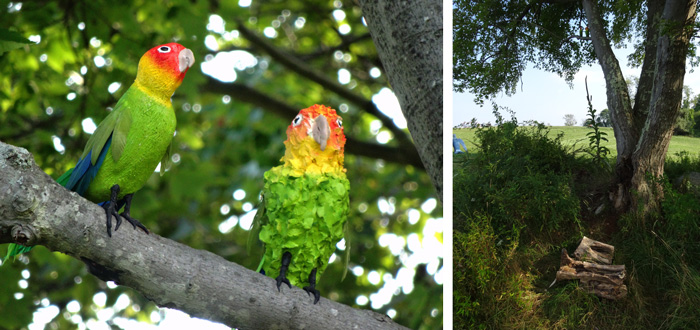
Lost Landscape (Copy)
Anna Adler
Ceramic & Mixed Media
Variable size
Lost Landscape alerts us to the existence of creatures once native to the New York area, now extinct, extirpated, or endangered. In this slightly bizarre, fictionalized tableau we can see a glimpse of a landscape from another time and contemplate the changes in our fragile ecosystem. Unfortunately, humans are most often at the root of its destruction.
“All that lives beneath Earth’s fragile canopy is, in some elemental fashion, related. Is born, moves, feeds, reproduces, dies. Tiger and turtle dove; each tiny flower and homely frog; the running child, father to the man and, in ways as yet unknown, brother to the salamander. If mankind continues to allow whole species to perish, when does their peril also become ours?” --- World Wildlife Fund.
Carolina Parakeet, Conuropsis carolinensis STATUS: Extinct
American Burying Beetle, Nicrophorus americanus STATUS: Endangered, extirpated in New York area
Karner Blue Butterfly, Lycaeides melissa samuelis STATUS: Endangered
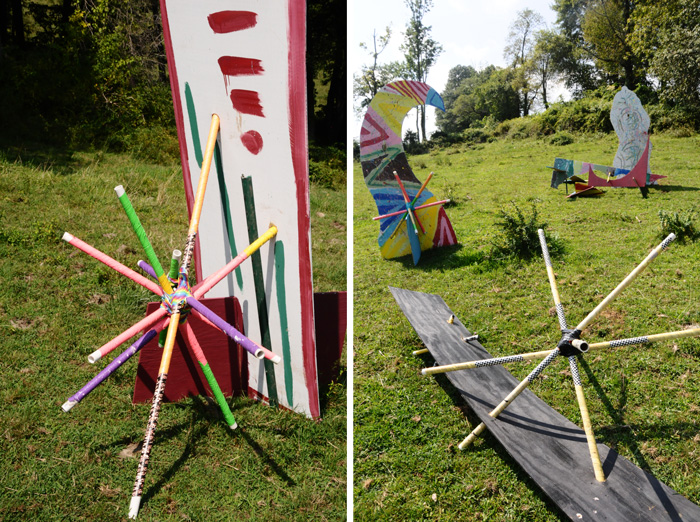
Paint Tag (Copy)
Elizabeth Barksdale
Plywood & PVC
8' x 25' x 25'
Paint Tag is named for my experiences making this sculpture with my children and their friends. I created the original design sketching sculpture ideas with my kids. When it came time to build, two of their friends came to help. All of the children helped cut panels with a jig saw. For each, it was their first experience using the tool and it was very exciting for them.
My daughter, Raven, and her friend Ruby, both 9 years old, designed and painted several of the panels. My son, Davin, 7 years old, painted several panels. Alex, Ruby’s brother, 12 years old, chose to spend his time exclusively with the jig saw. Prudent perhaps, because in the end, the younger children descended from concentrating on organized painting into messy childish bliss, a change brought on when my son stood up and suddenly declared “Paint Tag!” As you can well imagine, paint madness ensued.
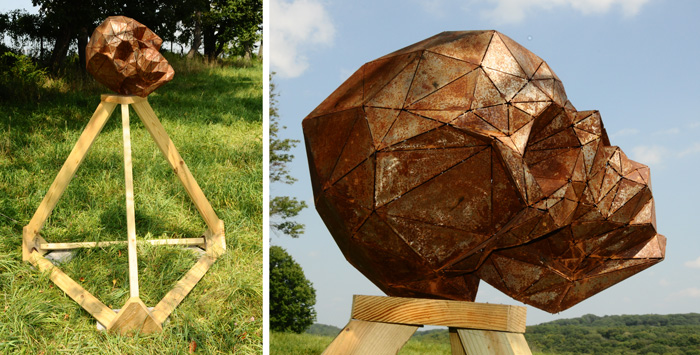
Geo-Skull (Copy)
John Belardo
Laser cut steel, wood
65” x 50” x 50”
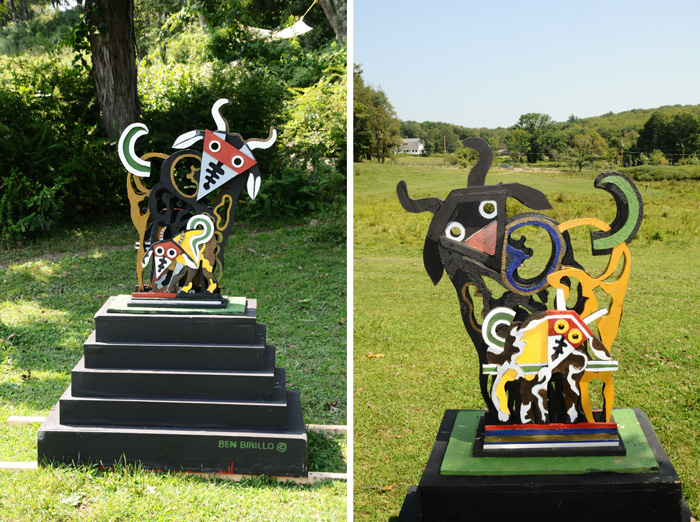
Little Goat (Copy)
Ben Birillo
Wood, paint
6' x 6' x 4'
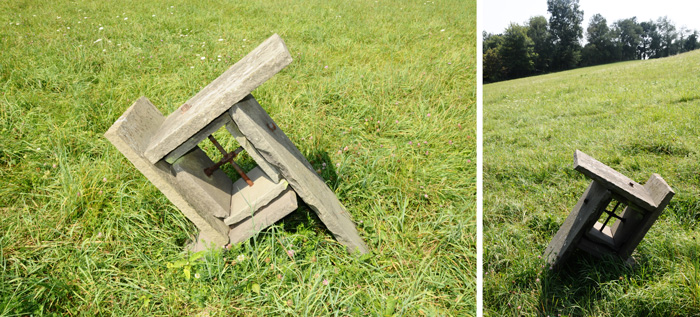
Tumbleweed Firma (Copy)
John BonSignore
Blue stone and steel
3’ x 4’ x 1.6”
The design of my sculpture begins with a broad concept: a place, person, animal, or emotion. After paring away the inconsequential details, what remains is the unique core of my subject. The unprocessed forms of stone are my primary medium; like the ideas I am interpreting, they are clean and uncomplicated.
The process is the same throughout my work: to capture that singular core that makes any place, feeling or living thing what it is. My sculptures become the physical representations of the essence of the subject.
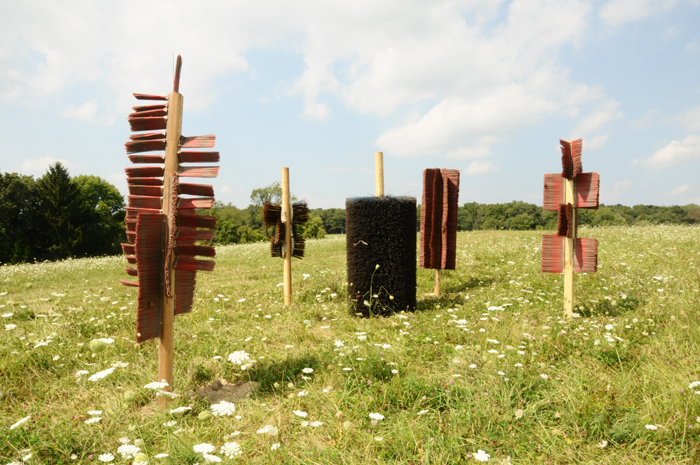
Cow Wash (Copy)
Cindy Booth and Jeanne Egel
Brushes/Brooms, Wood
10' x 5 1/2' x 20'
We are approaching the idea of public art with the idea that cattle and steed are our public. These sculptures have the primary residence of Saunders Fields in mind. They are meant to be touched, caressed, pushed, and walked into and used as scratching posts (for cows and horses). Materials for these pieces are recycled brushes from street sweepers.
Although mechanical in their former life, these sculptures have whimsy and lightness as their foundation, as well as the idea of behavioral enrichment for any bovine that may interact with them.
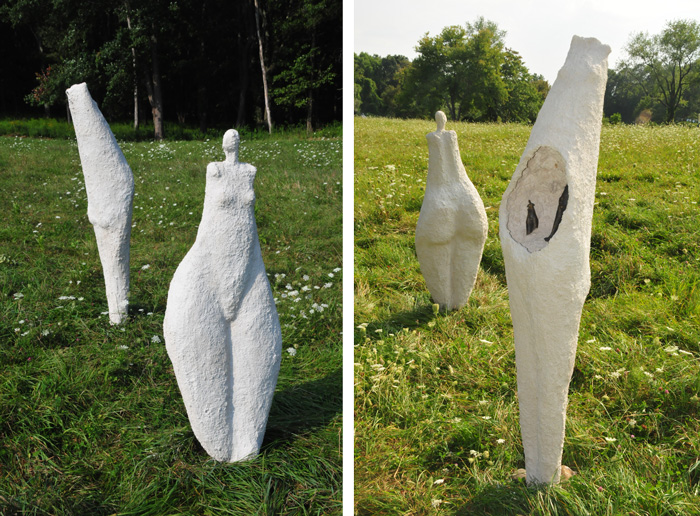
Disparate Women (Copy)
Jo-Ann Brody
Cycladic Take, Fossilcrete, 59" x 16" x 12"
Contemporary Take, Fossilcrete, clay, 73" x 16" x 12"
The conflation of creativity/fertility makes new sense with the inner figures in my current work. My newest granddaughter was just born this July. The inner/outer surfaces reflect my background in clay. They are birth to fully formed creatures: not holding or embracing but containing them. Are they fully fledged or broken fragments taking shelter?
The child is the father of the man; the muse the mother of new creation.
The formal elements include the stark contrast of creamy white and black, the relationship between inside and outside, the rhythm of the figures inside.
Working in cement is a slow regular pattern of mixing, applying, and evaluating that creates an atmosphere of contemplation: who I am, what I’ve accomplished in my life, and where I still can go. And then suddenly the piece speaks to me—telling me where it wants to go. The farm gives me a chance to experiment that I get nowhere else.
joannbrody.wordpress.com
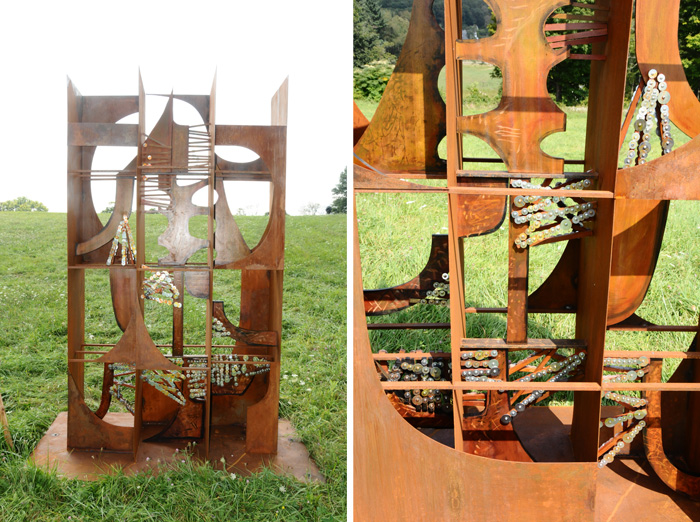
Altered Earth, Synthetic nitrogen farming; the consequential machine (Copy)
Susan Buroker
Metal and wood
10' x 6' x 4'
Altered Earth was inspired by the struggle to feed the growing population of the world in the late nineteenth century. This led to the introduction of synthetic nitrogen farming to increase crop yield. Over half of our population today is fed with the dependency on nitrogen fertilizer. Nitrogen fertilizer not absorbed by crops travels through water, soil, and air leading to contamination affecting our environment and human health.
Altered Earth represents the struggle with the imbalance of feeding the world and protecting our fragile ecosystem. The metal disks represent the nitrogen, symbolizing the contrast between the organic earth and the chemical that erodes it.
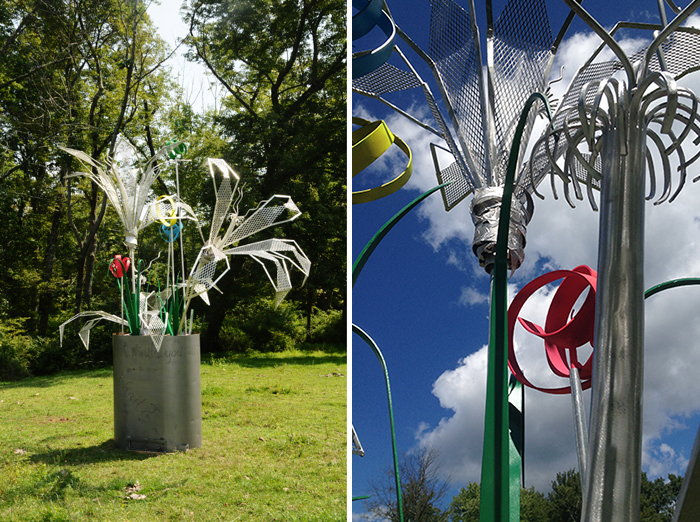
Life Is Too Short To Be Little (Copy)
Jodi Carlson
Aluminum, steel
7' (w) x 6' (d) x 13' (h)
“Life is too short to be little,” Benjamin Disraeli wrote. He continued with the sentiment that people are never so human as when they feel deeply, act boldly, and express themselves with frankness and with fervor. I will never forget how I felt on my first day of welding a metal sculpture--like my heart had opened up. Creating sculptures gave me a vehicle to act boldly and express myself with fervor. I am so grateful.
This sculpture uses a 300 gallon oil tank flipped onto its side as a vase for a bouquet of flowers. Lilies were created using expanded aluminum and aluminum diamond plate--materials more often used in commercial applications. And colorful, randomly curled elements were added, like garnish. Inside the oil tank is a 3-layer grid which allows stem-like tubes to be arranged, like flowers, in a myriad of arrangements.
Be inspired to “go big,” and act boldly. It’s worth the effort.
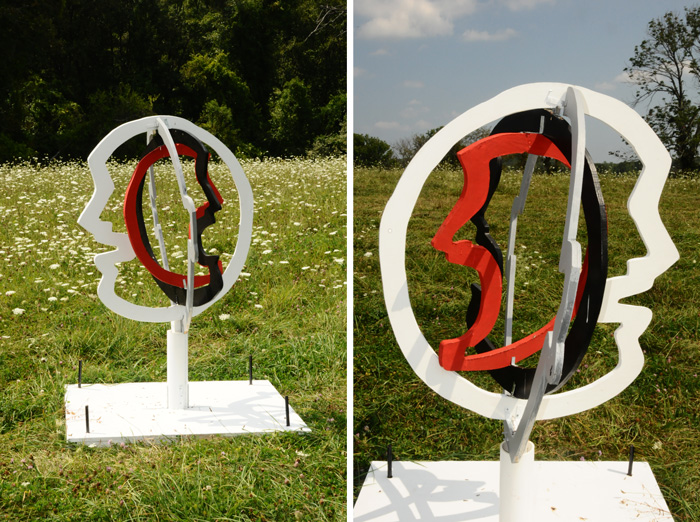
Spinning Profile (Copy)
Storm King School, Student Work; John Carruthers
Plywood, paint
61" x 50"
The Storm King School (SKS) is a small boarding school in Cornwall-on-Hudson, emphasizing real world experiences, experiential education, and community involvement. This collaboration could not have been a more perfect fit for those goals. Spinning Profile is an outline of a human face seen from 2 angles, forming a 3-D sculpture. It appears that the head is spinning and looking everywhere. It is a metaphor for what students do during their time at SKS. Spinning Profile was built by students after they created maquettes. The winning design was by Victoria Bobrova, a 9th grader. Dr. Nicole Shea of the Eisenhower Leadership Center contacted Storm King School about collaboraing on a community project. As the Co-Chair of the Art Department, John Carruthers thought the Farm Project would be a natural. The students visited the Polich-Tallix foundry in Rock Tavern, NY, and all had all been to the Storm King Sculpture Park, so they were excited about the possibility of building a larger piece for an open-air, “sculpture park-like” exhibit.
www.sks.org
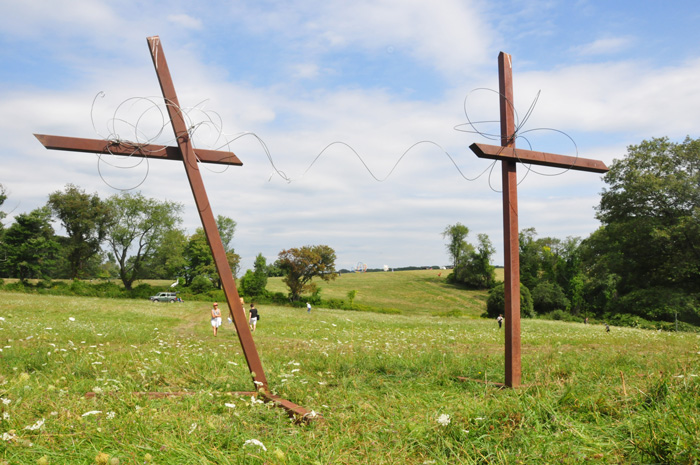
Attachment 3 (TO Attachment) (Copy)
Diana Carulli
1Approx 11’ x 22’ x 4’
Rusted Steel, Almaloy and Galvanized Wire
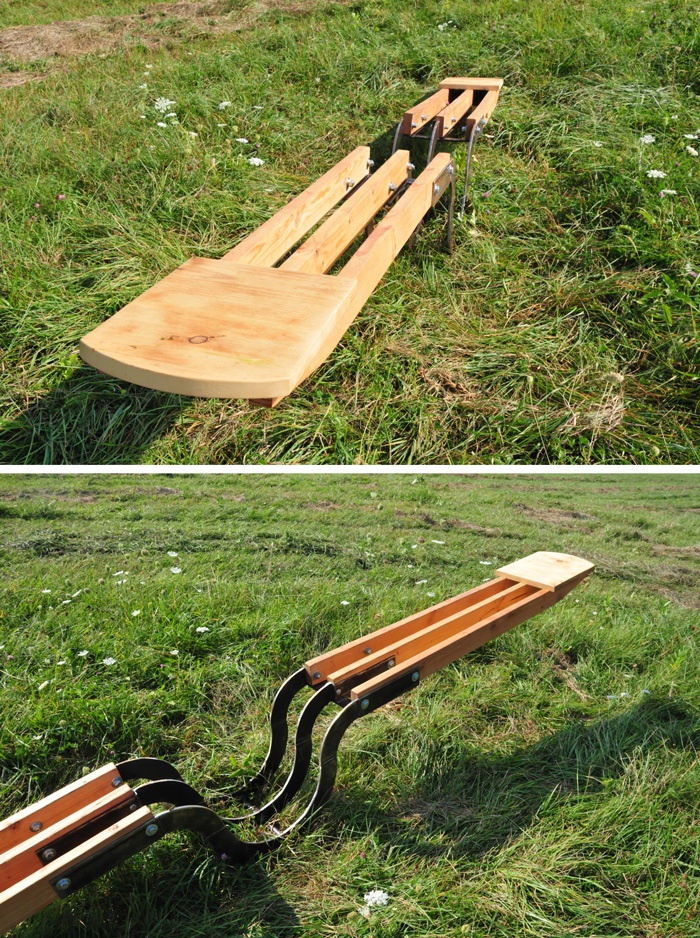
Wing Bench Form (Copy)
Steven Ceraso
Wood and Steel
2' x 14' x 1'
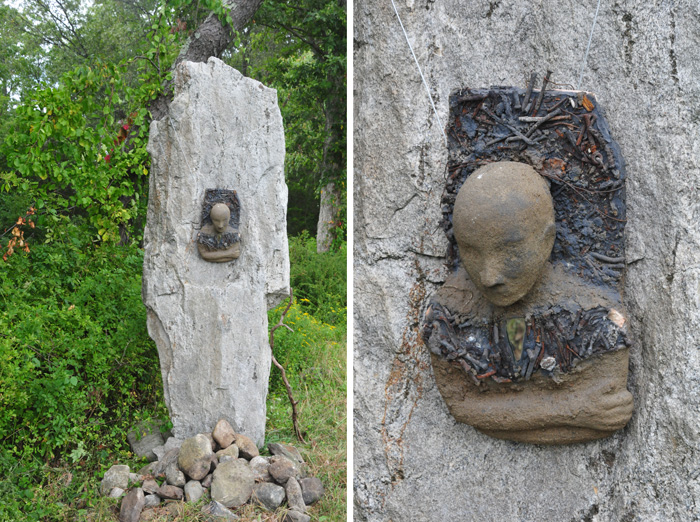
Seer (Copy)
Ada Cruz
Clay and mixed media
24" x 12" x 8" (approximation)
In folklore and in traditions of shamanic practice, a Seer sees the past, the present and, perhaps, the future. Often, a Seer is considered to be a person whose actions, attitudes and comportment are outside what may be considered “Normal” behavior, or rather, “deviant,” foreign or “alien.” This sculpture holds a mirror at eye level for the viewer to reflect on. Who is the Seer? It is my ninth year participating with Collaborative Concepts at Saunders Farm, and my fifth year putting together a small installation at the Farm’s “megalith.” As I reflect on the origin of this piece–exhibited first at “Deviants, Perverts, Aliens and Feminazis,” a collaborative the Ceres Gallery members and Vistas Latinas that confronted the absurdity of the terms given women and, in our case, artists by people like Rush Limbaugh–it seemed appropriate, indeed, site specific, to hang Seer as a necklace for the ancient stone.
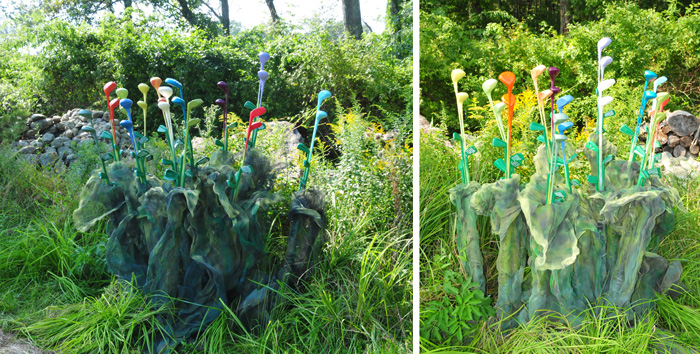
Art for Arthur's Sake (Copy)
Augie DellaVecchia
Golf clubs, metal screen, paint
6' x 4' x 1'
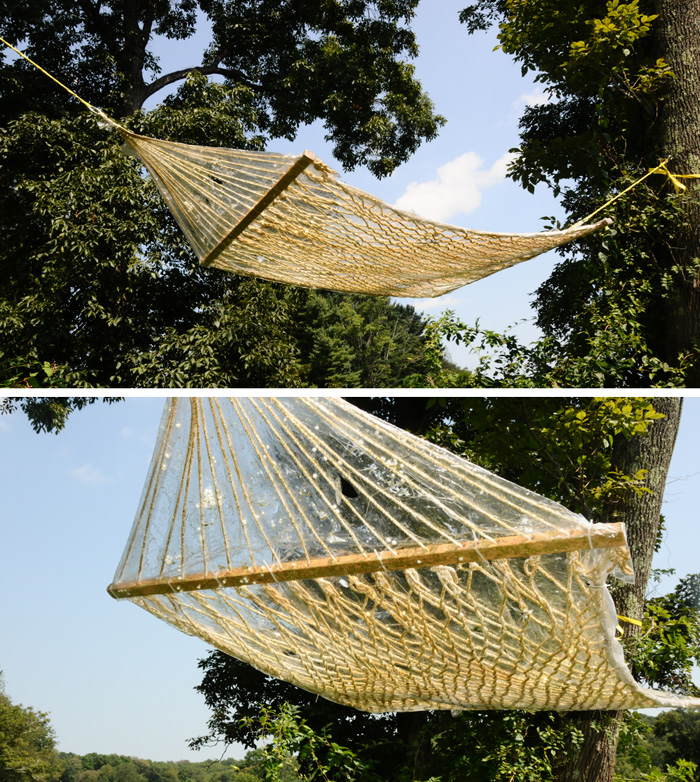
Jinja (Copy)
Florencia Escudero
Rope, wood, glitter, plastic
120" x 57” x 3"
I hope to create surfaces and moments for the investigation of perception and the ever-changing physicality of material in the world. I take into account light, color, touch, and the impossible task of holding onto the moment. My most recent work has focused on the production of flexible, portable objects such as hammocks. The hammock pieces are a combination of plastic and when they are displayed they can take on the qualities of stained glass creating the illusion of the reflection of water.
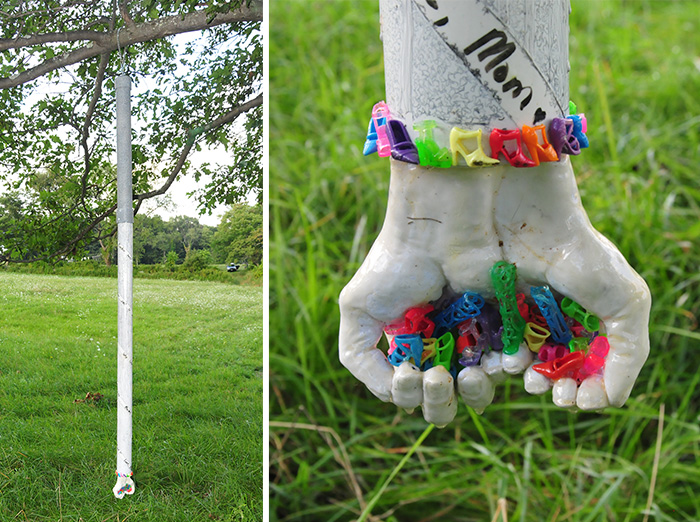
Your Soul is Not in Your Shoes (Copy)
Carol Flaitz
PVC piping, polymer clay, polymer resin
10' x 8" x 4"
The concept of this piece is a visceral humorous portrayal regarding the absurdities that fashion dictates for young women to the point that they are willing to damage their bodies. I have observed over the years the pain that women endure and the consequent damage to their feet, ankles, and spine through wearing 4-6 inch heels for hours and days on end. The purpose is to shift the way that the female walks, and at the lengthening of her legs to portray elegance and sexuality. Unfortunately, the result is a woman who cannot walk quickly, who often is in pain, and, if this continues for years, foot, ankle and spine damage result. Furthermore, Barbie as a physical ideal given to little girls enforces this concept. She needs a stand to stand!!! My message is for my daughters and the next generation of women.
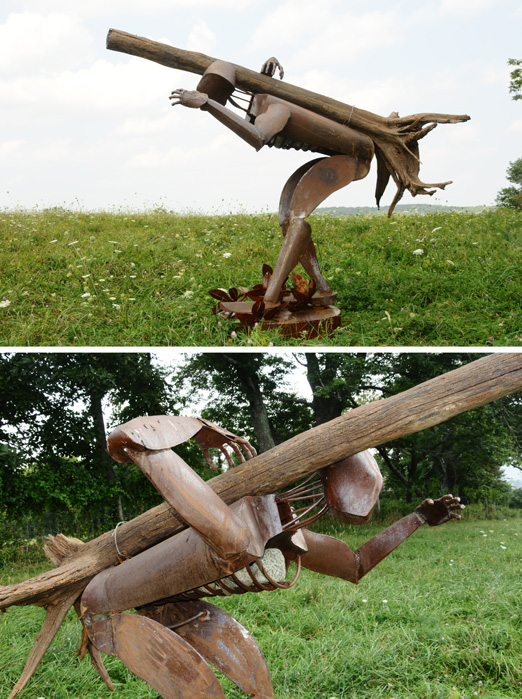
The Last Piece of Wood (Copy)
Denis Folz
Steel and Wood
7' x 7' x 4'
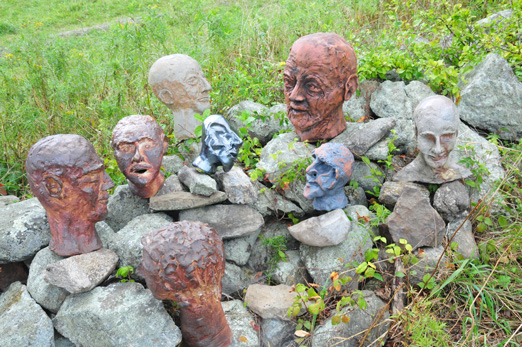
CONVERSATIONS (Copy)
C. Robert Friedman
Clay, natural wood fire glaze and commercial glazes
Dimensions variable
Art provides both the viewer and the artist with new ways of seeing themselves and the world around them. The medium I use to express this is clay. In my relationship with it, I continually seek to integrate the four basic elements of life (earth, fire, water, and air) and blend them into compositions of human attitudes and emotions. Frequently ambiguous in form, androgynous in character, yet easily accessible, each piece I create is meant to draw the viewer into an intimate and involving relationship.
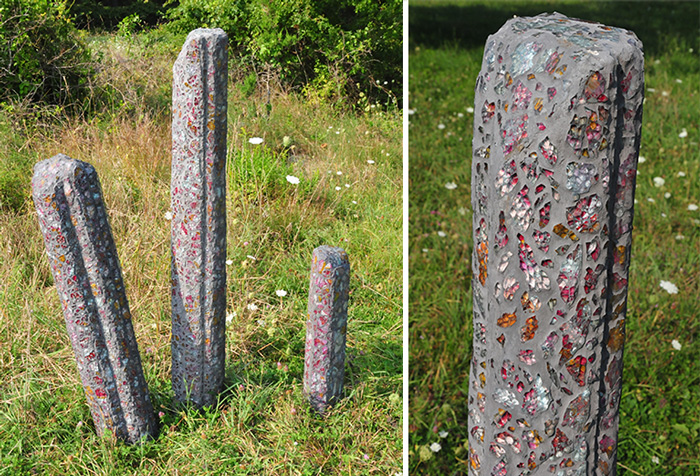
Untitled (Copy)
Barbara Galazzo and intern, Colby Meagle
Mixed media mosaics
3 1./2' x 3' x 1'
These mosaic crystals are what I imagine to be lying under Saunders Farm’s rich soil. Researchers at the University of Southampton announced that they are able to store and retrieve huge amounts of five-dimensional data on quartz crystals. They have named it “Superman memory crystal” – after the “memory crystals” used as storing devices in the Superman films. They claim that using ultra-fast lasers, we can now encode a piece of quartz with 5D information in the form of nano-structured dots separated by only one-millionth of a meter. If true, then the storage allows unprecedented parameters including 360 TB/ disc data capacity, thermal stability up to 1000°C ,and practically unlimited lifetime. Now, this wonderful discovery that enables us to store huge amount of data that can be retrieved even after millions of years, makes us think about the possibility of our ancestors doing the same, hoping we would retrieve it someday.
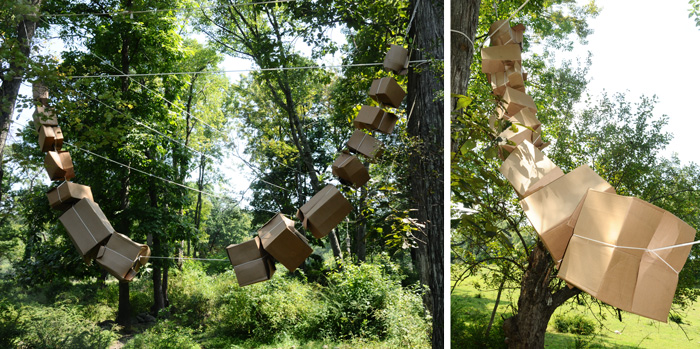
Continuous Draw #8, Sequester (Copy)
Ruth Hardinger
Rope, concrete and cardboard
approx 35' x 30' x 40'
A volumetric space, outlined by ropes, is in the farm where trees, wildflowers, plants, birds, insects, and more species live. Continuous Draw #8, Sequester, is in this region of trees that sequester carbon. Anchored in opposite sides of the triangle, the concrete rings, centered between the tree-trunks’ V-shaped spread, are likened to rings of worry beads or markers of time. A large strand of rope holding cardboard boxes marks the entrance. During the exhibition’s time frame, the cardboard box gate will deform and modify by nature’s processes including rain, wind, sun, and cold. This installation could be called a short-lived forcing of change, which echoes my concerns about the speed of what is happening as our climate changes.
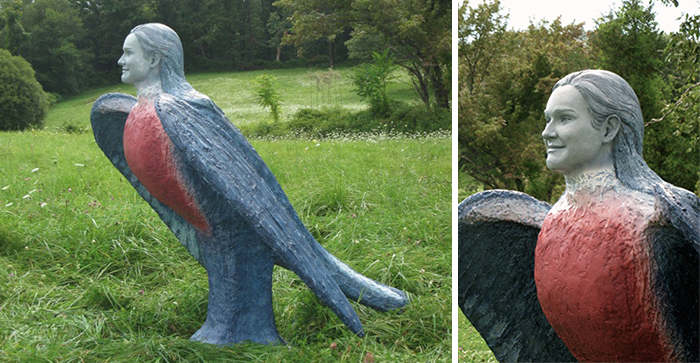
Hirondelle (Copy)
Sarah Haviland
Reinforced Forton MG cement
51” x 48” x 48”
I am fascinated by human-bird hybrids, expressive personas existing in a parallel world to our own. Hirondelle is the newest in a family of bird-figures, this one resembling a blue, red-breasted swallow ready to take wing. These sculptures are inspired by the long history of mythological figures relating to the soul, found in images and tales from cultures worldwide. Along with large cement and resin sculptures like Hirondelle, based on specific portraits, I make small bird-size figures in ceramic, Aqua-resin, and bonded metals.
www.sarahhaviland.com
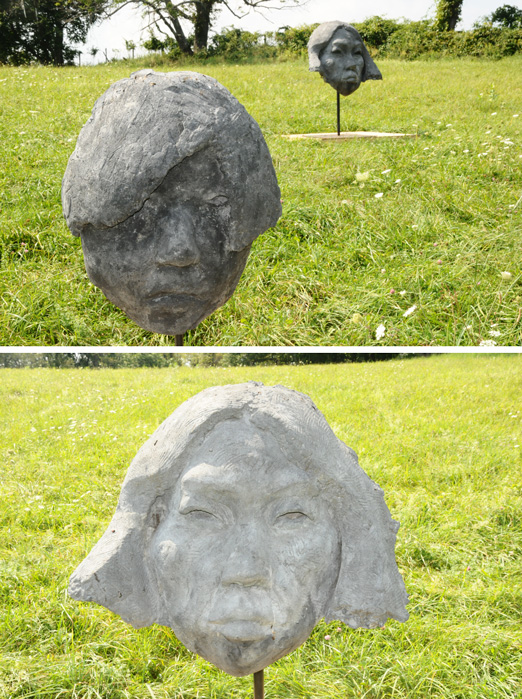
YUKO YOSHIDA, CHERRY FU, NATALIA (Copy)
Barney Hodes
YUKO YOSHIDA, approx 3' X 4' X 18'
CHERRY FU, approx. 3' X 3' X 18'
NATALIA, Approx. 30" X 24" X 15'
All three cement
As to statements, Matisse once said that artists should have their tongues pulled out because if the work doesn’t say it, what does? I’d like to keep mine, so instead of making a statement I’d ask a question, “How do we see people of an ethnicity different from our own? As individuals with characteristics that are uniquely their own, or as representatives primarily of their “own kind”?
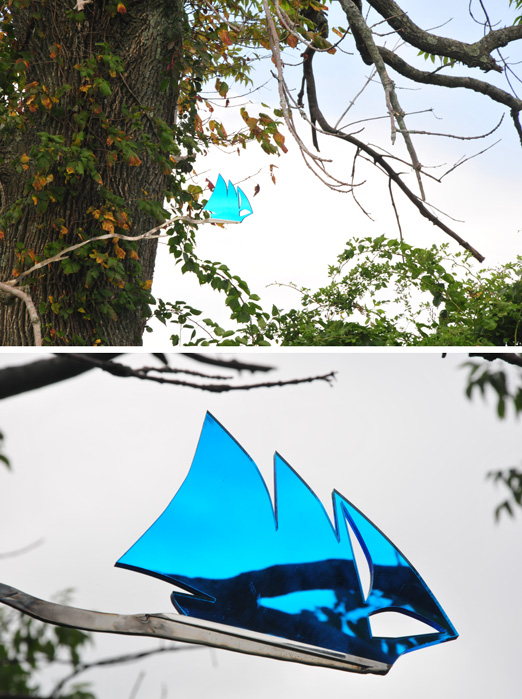
To the Other Side of the Horizon Line/For Eric (Copy)
Cathrin Hoskinson
Mirrored plexiglass and stainless steel
8” x 10” x ½”
To Eric Arctander, an enthusiastic organizer of the Farm project with the Collaborative Concepts team, who passed away suddenly last year. His cheerful presence is deeply missed by everyone at Saunders Farm this year. To me he was synonymous with the fun of the event, which I treasure for the opportunity to experiment in an inspiring setting with few creative restrictions. He seemed to be everywhere and I had the impression he liked everyone’s work, every year, and of course one was inspired by his efforts to help with the organization of the show. Of my own projects he had been most fond of a stainless steel sailboat that I mounted on a tree branch several years ago. Although the cows liked to push it over, I have a wonderful photo of my intention, which was to express the hopeful feeling of the future, as seen from the top of the ridge and over the waves of the distant hills. So this year I am returning to this theme and have made another boat, smaller in scale–farther away–suggesting the dimension that we cannot see where the spirit and energy of those who have left us still reside.
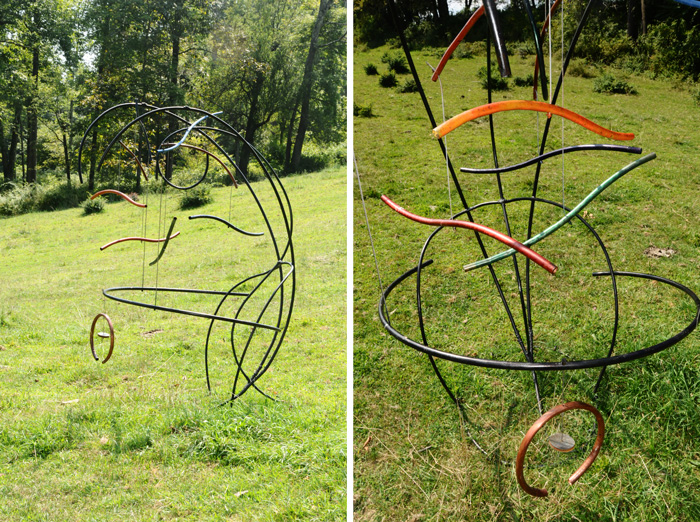
Waves (Copy)
Eric Jacobson
Brass and copper tubing, stainless steel cable, dye patina
84” (h) x 48” (w) x 81” (d)
The work consists of curved “lines drawn in space,” interacting with one another, and defining space. It was important to me to incorporate color, movement, and sound. Relationships change as the brightly colored elements move in the wind. Sound brings another sensory field into play. The dyed copper and brass tubing clang as the pieces collide. The piece is inspired by living, organic forms: vines, tree branches, underwater plants. When the wind passes through the elements of the sculpture, it affects them but does not alter them. Inspired by Calder mobiles and Kandinsky paintings, I am exploring the concept of three-dimensional painting, in which the curving copper tubes form the painted “lines” and define positive and negative space.
www.jacobsonsculpture.com

The Elemental (Copy)
Joseph Jaskolka
Black Granite, River Stone, New England Field Stone, Connecticut Micah, Steel, Fire, Water, and Wind.
8.5' x 6.5' x 6'
The Elemental is a basic yet complex presentation of the four Classical Elements, embodied into one being. Anything at all, that can be experienced in any way, will have elemental qualities that can be sensed and responded to. If this is true, the elements can be understood as the fundamental basis of the relationships between extant things, the source of shared qualities, the root level of correspondences that ultimately form the orderly, coherent, and therefore predictable world. As one's awareness of the elemental qualitties of things increase, the world appears more predictable. To me, The Elemental is an image of someone who has mastered the recognition of elemental qualities, from the most simple to the most intricate, therefore mastering life itself.
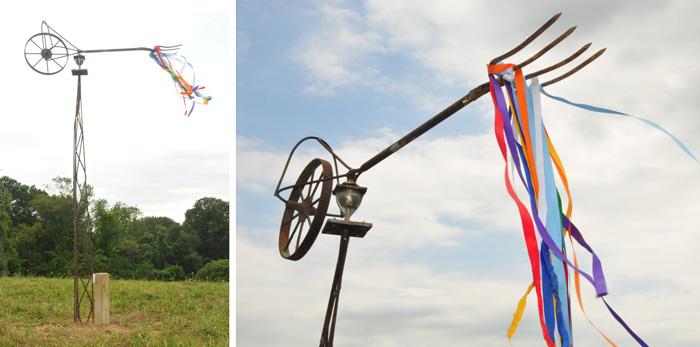
Cow Catcher (Copy)
Thom Joyce
Welded steel
My art is a pure expression of my joy and my insane approach to life. I create each piece with an idea in mind but I allow the creative process to take me on a journey. The sculpture itself tells me when its done. I had a larger vision for Cow Catcher but while setting up the connection of the top to the tower, I realized that what I had was the finished piece. I have cast, welded, bent, cut, and found metal to bring my vision to life. I had not been focusing on sculpting for a while and, with this new piece, my love of the process has been rekindled.
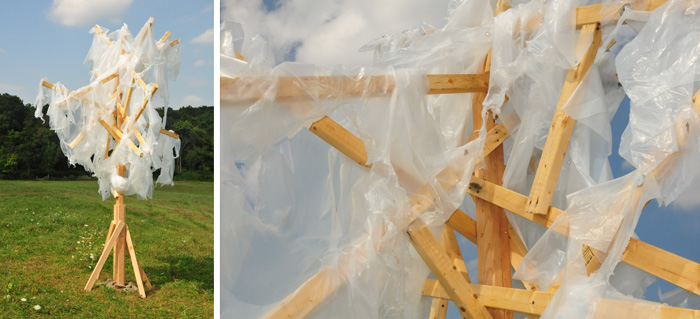
Untitled (Copy)
Kevin Laverty
Wood and plastic
14' (h) with variable dimensions in all directions
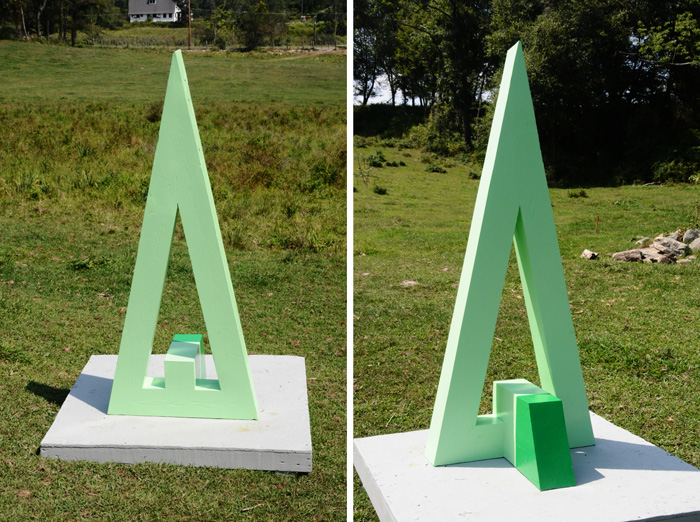
Stargazer (Copy)
David Link
Wood
6’ x 3’ x 1 1/2’
Inspired by the Minimalist Art Movement of the 1970s, David seeks to continue in the tradition of “Less is More,” where harmony, peace of mind, and balance combine like the statues of Buddha in meditation. Effective use of color and negative space further enhance the strength and power of his work.
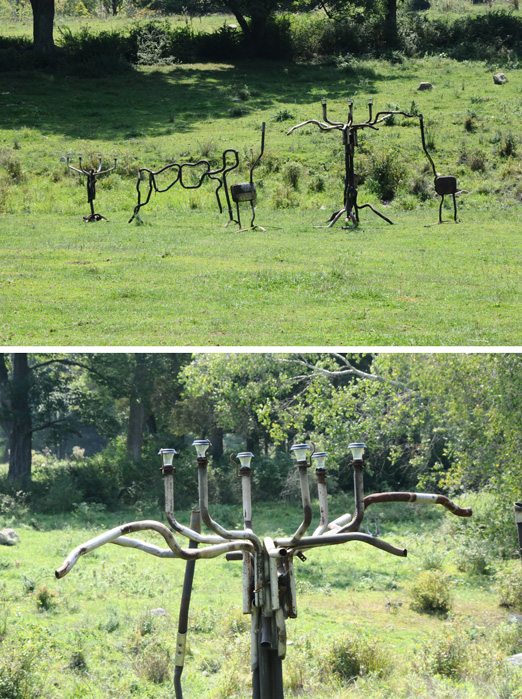
Peaceable Kingdom (Copy)
Jim Lloyd
Welded steel
9' (h) by variable
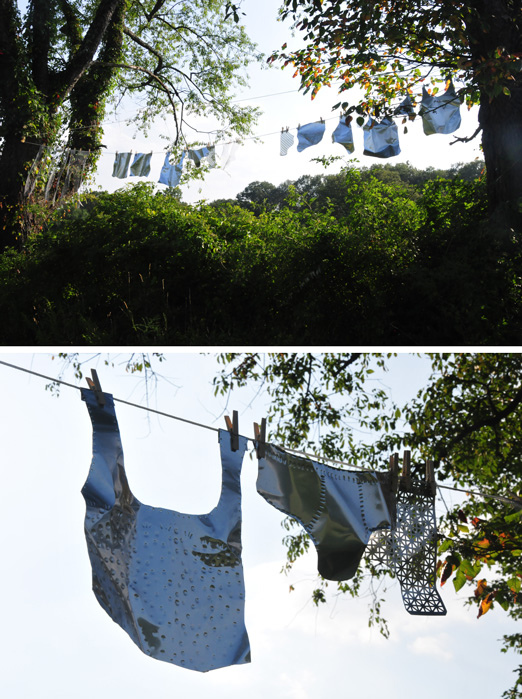
DRIP DRY (Copy)
Brook Maher
Metal, rope, clothespins
Textiles are among my favorite forms of artistic expression. Color, pattern, texture, line, form, and detail challenge the bountiful inventiveness and craftsmanship of the creators who are, more often than not, anonymous women. Textiles are both practical and necessary, yet also can be wildly or subtly expressive. Clothing is personal and my artwork always comes back to the personal.
The Saunders Farm show provides an ideal venue for experimenting with new media. I have been spending a lot of time in the past few years at my home away from home in Taos. New Mexico has a long tradition of metalworking, including decorative objects of pierced tin and copper. When I began to render most of the garments for my clothesline from flexible sheets of aluminum, they required something more to give them definition and personality. I used a hammer and nail and a screwdriver to pierce and make impressions on the metal, mimicking needlework. I wanted the garments on the line to “read” as three-dimensional without actually being so.
Drip Dry is also meant to be enhanced by the natural environment, reflecting changing light and colors from the sky and adjacent foliage and making a kind of music as the garments dance in the wind.
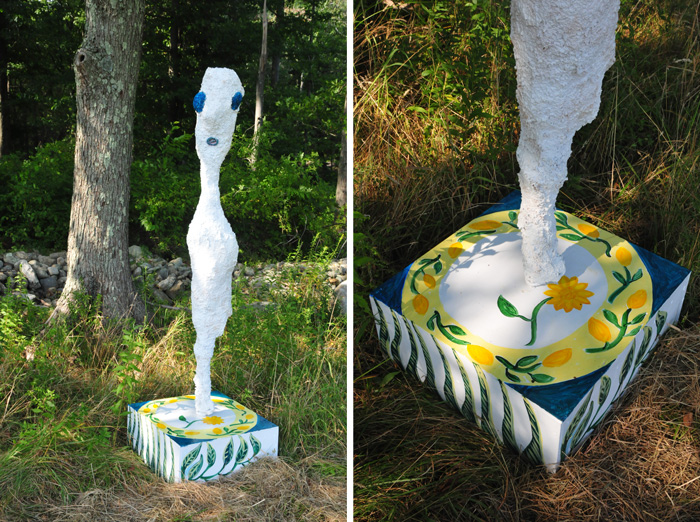
A Small Ghost for Eric (Copy)
Lynne Mayocole
Mixed
7’ x 2’ x 2’ (includes base)
My Small Ghost for Eric is a memorial piece for Eric Arctander. He was my sponsor last year at Saunders but died shortly after the middle of the exhibition. I first knew Eric when we were both artist adjuncts at Bronx Community College many years ago. Our lives wove in and out since then, most spectacularly a few years ago when he facilitated my and my partner’s trip to an amazing adventure in Provence. I painted the base of my sculpture with motifs from that area.
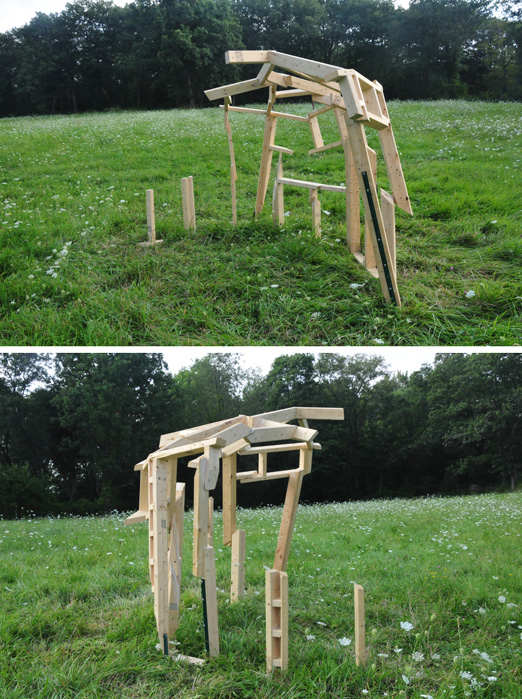
Untitled (Copy)
James Mulvaney
Wood studs
140" x 48" x 69"
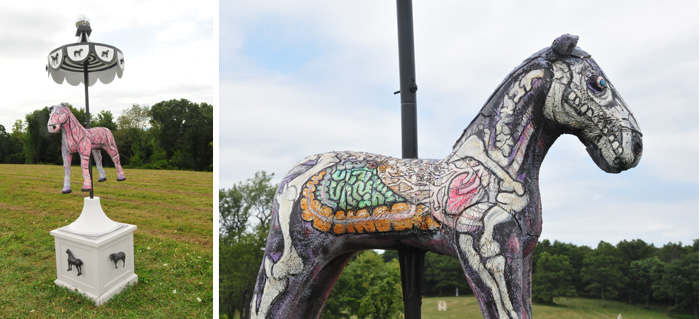
Carousel Carcass (Copy)
Michael Natiello
Mixed Media
Approximately 8’ x 3’ x 2’
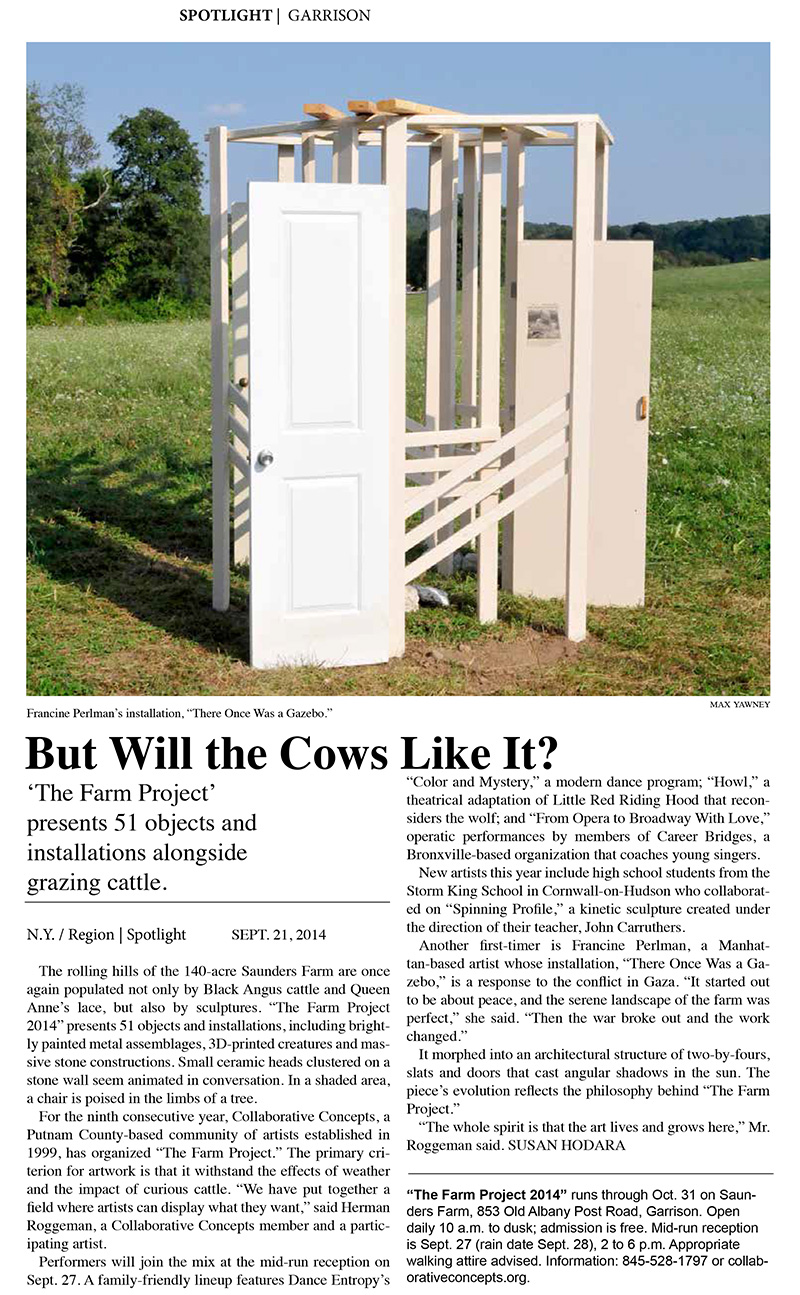
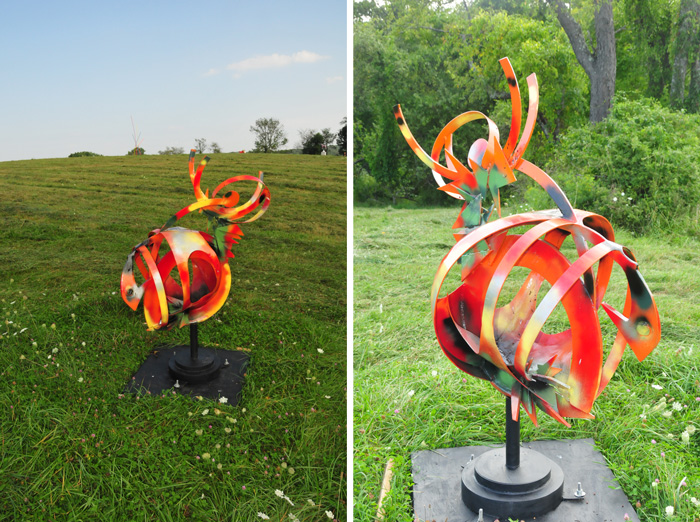
PISCES DENIED (Copy)
Jerome Harris Parmet
Welded Painted Steel
72" x 36” x 24”
My artistic mode of expression is specifically steel sculpture– the strength and durability of the material versus its surprising liquidity and malleability fascinates me. I want my art to speak for itself from my feelings to the viewer’s emotions. Therefore, I work primarily without a preconceived plan or concept, as the outpouring of absorbed experience plays a major role in guiding my hands and achieving their goals. I might say it’s almost spiritual.
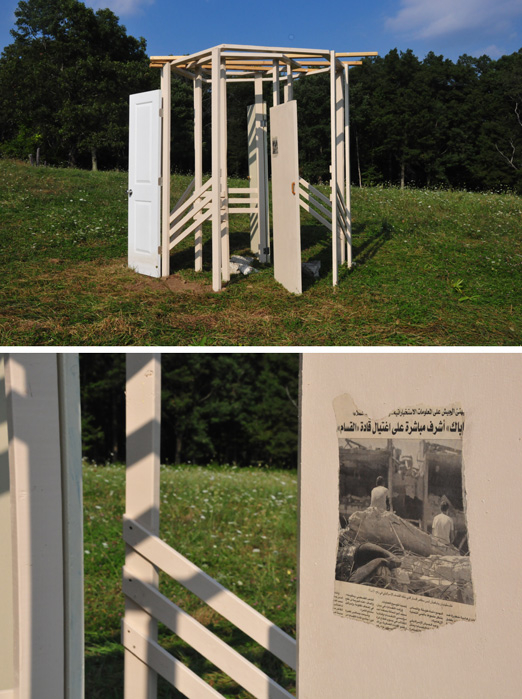
There Once Was a Gazebo (Copy)
Francine Perlman
Wood and paper
7' x 7' x 7'
Conceived as a gazebo, my work was hopeful about the possibility of peace in the West Bank. But during its development, the entire Middle East met calamity after catastrophe, and the piece changed accordingly. I could no longer festoon its surfaces with colorful Palestinian and Israeli cultural icons. It’s still a quiet piece, because I am still a minimalist, but I’m hoping it causes people to reflect, to be moved, and to ask–what does she mean by that? as I have been moved to ask myself. I hoped that by calling it There Once Was a Gazebo, people would know I meant there was a peaceful place and now there isn’t, and I hoped that the two newspaper photos in the piece would convey that I am now talking about Gaza without telling people what to think. But not everyone is as obsessed with that part of the world as I am, so if people don’t get the narrative, I think the aesthetic solution stands on its own, a very important aspect of all my work – room-like, lines, shadows.
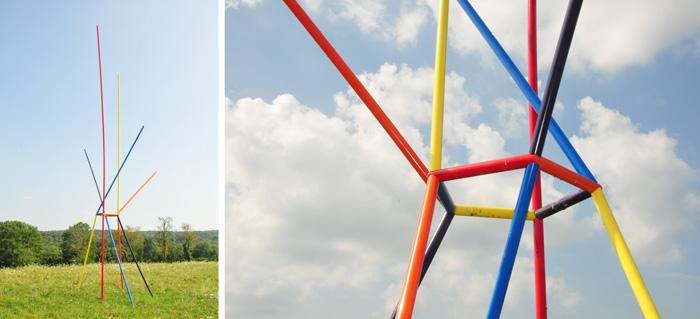
The Fifth Noble Truth (Copy)
David Provan
PVC pipe, steel armature
28’ high
The Fifth Noble Truth is a direct response to the demands of the Saunders Farm site, as filtered through my perception, skills, and biases. I understood the site to require: Monumentality (to be seen within the vast expanses of the Farm, it is 28 feet high); Durability (to withstand wind, rain, and cows, it’s fabricated from super-stable PVC pipe, over a steel armature); Colorfulness (to stand out in the overpowering greenness of the place, it is painted the full spectrum of Rustoleum spray paint, excluding green); and Cheapness.
The title, The Fifth Noble Truth, refers to an addendum to the Four Noble Truths of Buddhism that occurred to me while designing and building the sculpture: “Can one desire to be free of desire?”
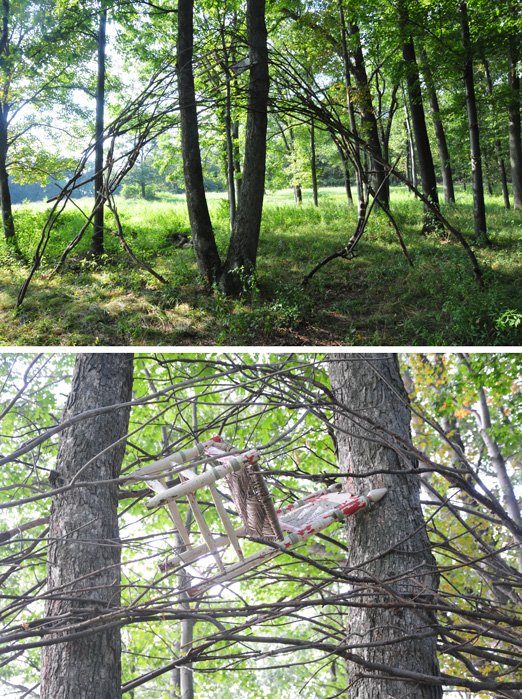
Displacement/Flow: Hudson Highlands, 2014 (Copy)
Winn Rea
Found branches, chair, twine
15’ x 20’ x 12’
Displacement/Flow: Hudson Highlands, 2014, is one in a series of temporary environmental sculptures where a chair is a stand-in for human presence in nature. Found branches are lashed together, arcing up and around a chair wedged between the twin trunks of a tree. The fluidity of the arc juxtaposed with the visual compression of the twin trunks are a metaphor for the complex relationship between humans and nature. Winn Rea’s environmental, process-based art includes sculpture, video installation, and works on paper. Her work, exhibited nationally and internationally from New York, to Grand Rapids, to Seoul, has been reviewed in The New York Times, Geijutsu- Shincho, (a monthly Japanese contemporary Art magazine,) The Huffington Post, and AlterNet. Rea is Associate Professor of Art at Long Island University—Post, Brookville, New York.
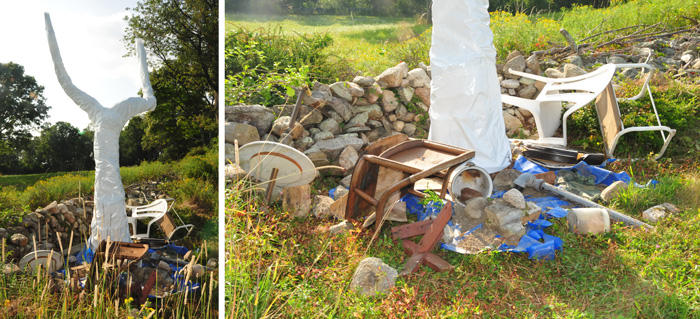
Gaza (Copy)
Sheilah Rechtschaffer
White plastic shrink wrap on a dead tree, bricks, cement, dirt, various discarded items
Approximately 14'
A stunted tree remains from last year. Its awkward shape seems brutal. Life over. Covered in white plastic, the shrouded tree is a symbol of an uncertain future. At the base are scattered remains from blown-up buildings. What isn’t there is the blood and the smell. The decades of this endless conflict go by. The violence increases and the latest news is a ceasefire. We become either anesthetized or obsessively seek newest information. We can do little. But we can bear witness. We can empathize and we can speak out against this human catastrophe and say “not in our name.” And we can hope that the latest ceasefire can lead to justice.
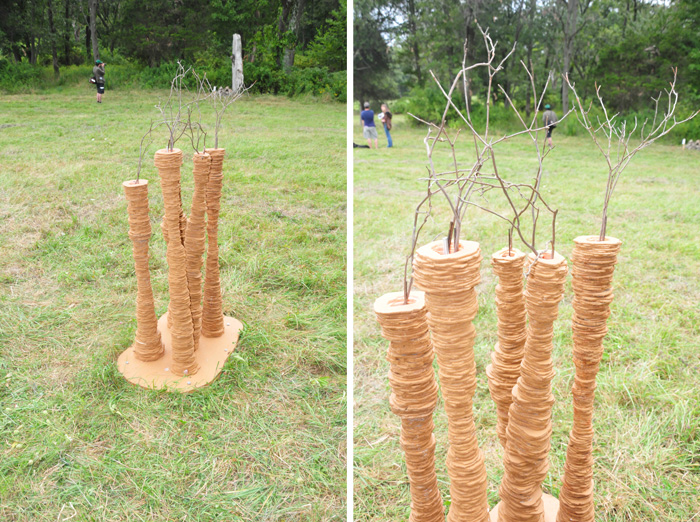
The Grove (Copy)
Karen Roff
Recycled and new plywood, branches
22" x 33" x 72" approximately
The Grove is a cluster of five separate tree-like shapes that share a communal base. The name of the sculpture evokes the memory of the places in the woods that we explored when we were children, and discovered wild undisturbed settings that all possessed a distinct specificity, unlike the ‘manufactured’ landscapes of the suburbs that are not really natural or unique. The fabricated aspect of the piece is a reference to this human intervention upon the landscape, but also recalls how we would spend hours constructing little mini environments out of natural and synthetic materials. Close observation of the work reveals that what from a distance looked homogeneous is actually an accumulation of similar but disparate sections of wood from diverse sources, hand cut and stained, which when combined integrate the past into the present and create a new unity. The original objects include a plywood side panel from a backyard playset that we made for our daughter, sections of old art projects formerly painted metallic silver, and random panels from the garden, making the trees fragmented and irregular, like memory that is incomplete and disjointed, bits of substance in a non-linear sequence.
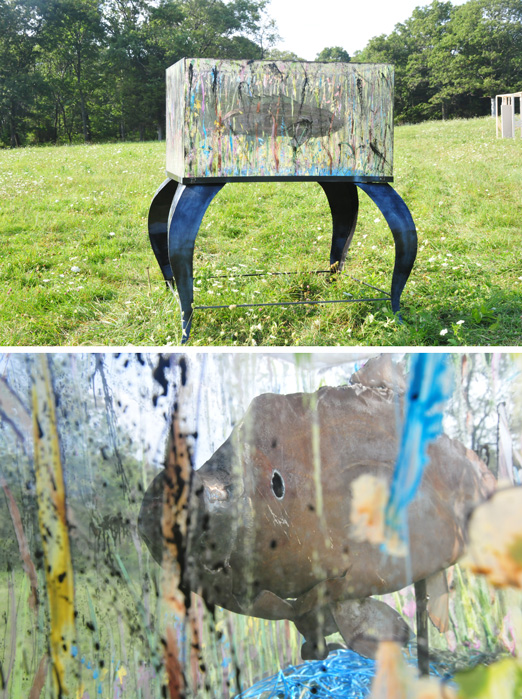
Aquarium (Copy)
Herman Roggeman
Steel, plexiglas, paint
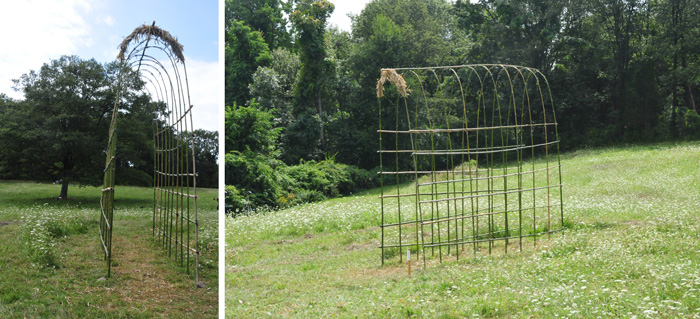
Passage (Copy)
Mario Rusich
Bamboo and twine
10’ x 4’ x 12’
Passage tries to evoke and suggest the transition that we have to make at this point in our universal history. By using natural materials my work tries to embrace and reconnect to the organic underpinnings that make us part and not separate from nature– all that has been lost by our modern, post-industrial worship and total reliance upon empirical, analytical, and the scientific way of life. We have become completely separated from “nature” and our part in it.
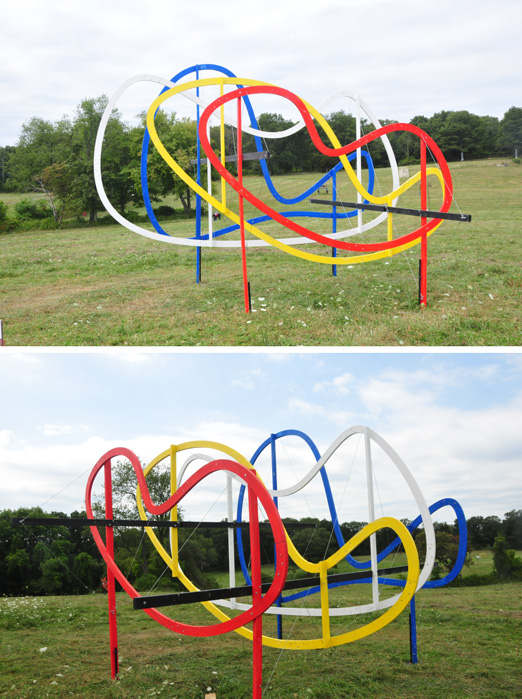
Loop The Loop (Copy)
Peter Schlemowitz
Painted Plywood
20’ x 21’ x 13’
Loop the Loop is a culmination of four interests: large-scale, endless sculpture, use of color in sculpture, cable-based sculptural support systems, and sculpture as a constructivism or assemblage of independent sculptural elements. The colors, inspired by a restricted De Stijl palette and the organically shaped forms relate to the formal vocabulary of my past pieces. The cable support structure is based on the truss bridge design model. This piece’s composition, in contrast to my earlier large-scale sculptures which are composed of closed obliquely connected shapes, is composed of a series of parallel open shapes that are not directly connected to each other.
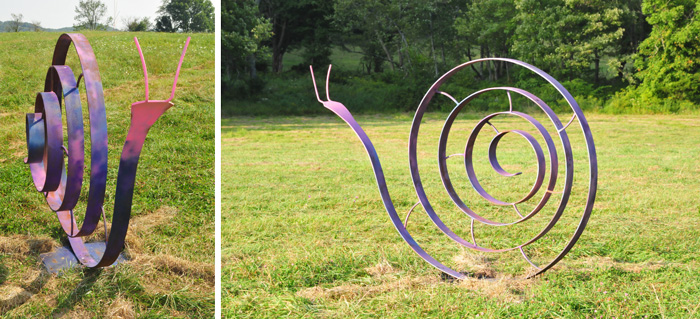
Wear R U Gong Les Cargo? (Copy)
Chuck von Schmidt
Steel
6’ x 8’ x 2.5’
This terrestrial pulmonate gastropod mollusks's approximation is a memorial to my first NY pet, “Snailie,” whom I found at an Italian Fish Market on Bleeker Street back in ’69. A real party animal, he would keep me up at nights as he noisily chomped on lettuce. We were pals when Armstrong first set foot on the moon.
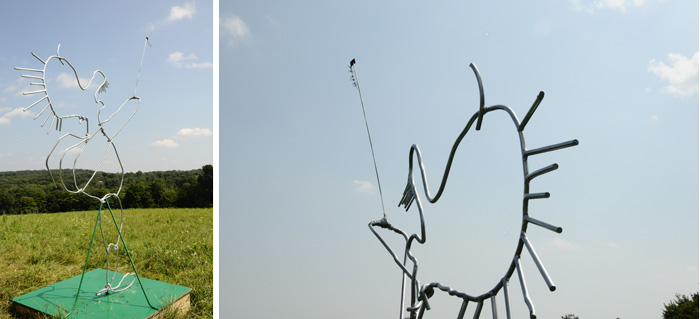
Old Man Flying a Kite (Copy)
Fred Schlitzer
Steel
7 1/2’ x 4’ x 1’
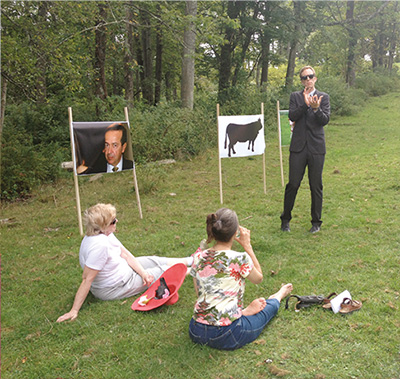
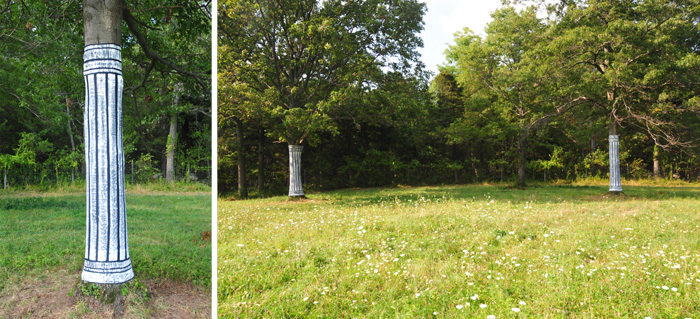
Columns (Copy)
Hideki Takahashi
Special acrylic on Denim canvas
10’ x 9’ each
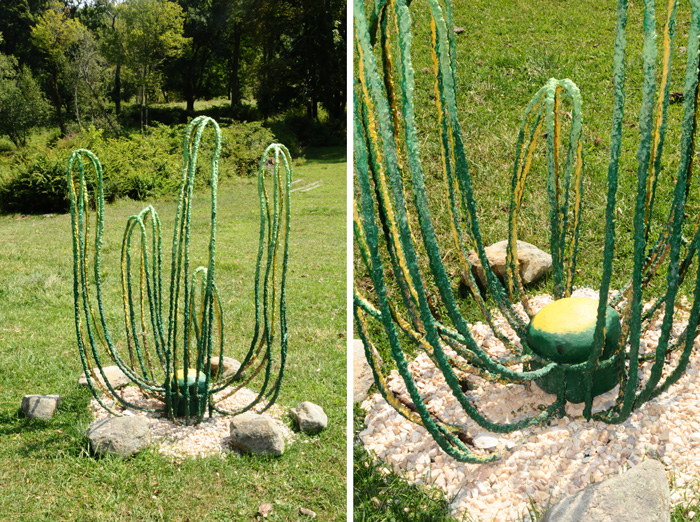
Cactus Conundrum 2013 (Copy)
Naomi Teppich
Steel rebar, steel mesh, cement, cement enamel
66” x 46” x 31”
My sculpture is a linear outline of a saguaro cactus. I have been attracted to this dry weather plant form for several reasons. First of all it is a totally organic shape which I find interesting. I have placed this desert plant sculpture in the Northeastern quadrant of the United States, specifically Garrison, NY. The viewer may wonder why is a cactus growing on a farm in New York state. It gives me the opportunity to affect the viewer and alert him or her to the warming nature of climate change which can affect our gardens, nature as we know it, and weather conditions. It was also shown at the Green Door storefront window in 2013. I have built several cacti pieces in the last few years. I have exhibited them at the Kingston, NY, Sculpture Biennial, Saunders Farm Collaborative Concepts sculpture park, Garrison, NY, and a very large piece was exhibited as part of a solo show in 2012 at the Catskill Art Society & Art Center in Livingston Manor, NY.
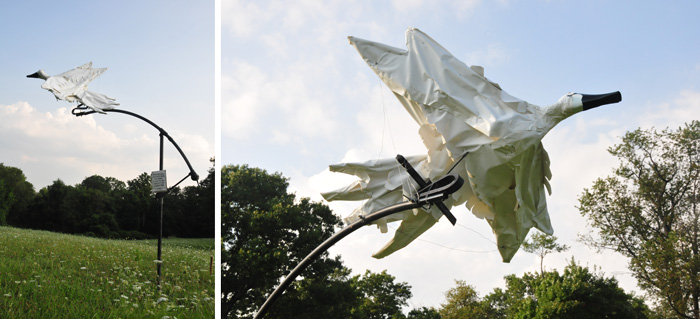
Honker Swan (Copy)
Jim Thomson
Vinyl and plastic
5.8' x 5'
Being born in a duck yard does not matter, if only you are hatched from a swan’s egg.
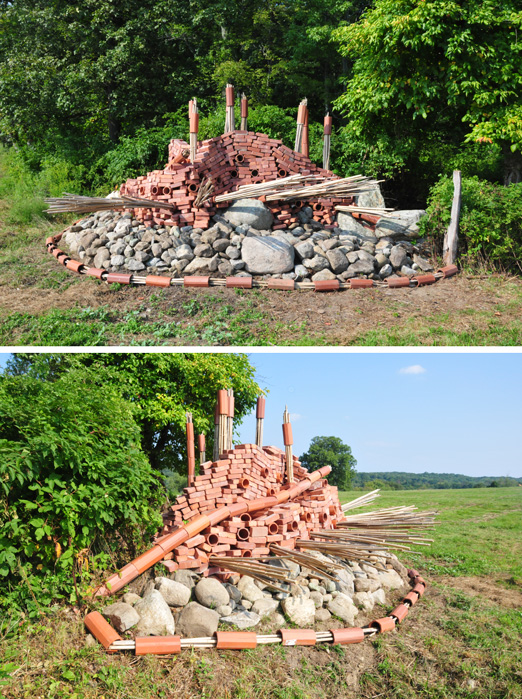
Red Cap (Copy)
Alex Uribe
Brick, clay tile, bamboo and stone
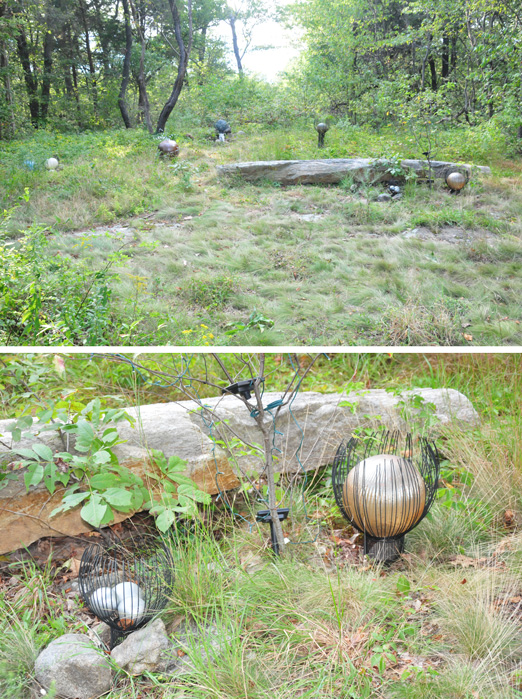
Combo #9 (Copy)
Eva Whorley
Mixed media
Dimensions variable
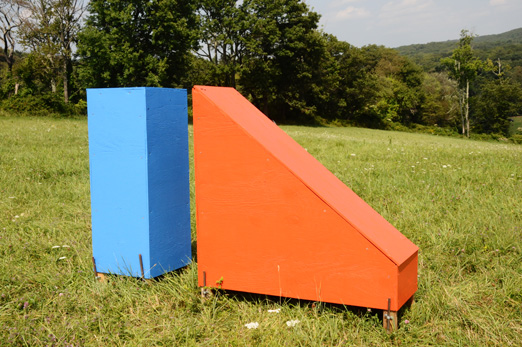
Two Related Objects, blue and orange (Copy)
Ellen Wilkinson
Painted Plywood
4.5’ x 6’ 10” x 18”
This piece is about geometry and perception. The two objects have the same dimension in depth and height but are different shapes. The orange triangle is truncated so that all three sides are of equal length. Orange and blue are complementary colors, but the orange object reflects light much more powerfully than the blue. The blue shape disappears in certain light. The blue and orange shapes are not touching, but from several viewpoints they appear to be. The viewing experience changes as the sunlight and clouds animate the objects from above.
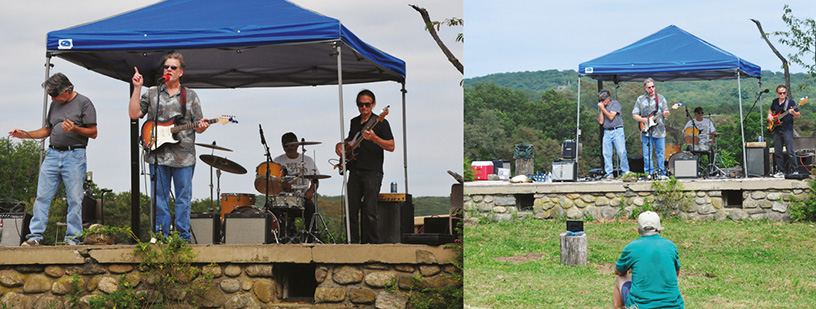
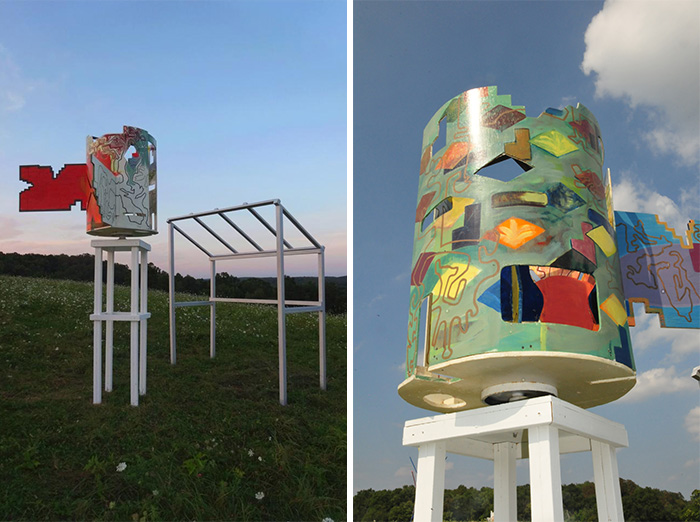
Bus Stop/(spinning) Buffalo Wings (Copy)
Dieter Kuhn and Max Yawney (collaboration)
Paint on wood with potters wheel
12’ x 8’ x 12’